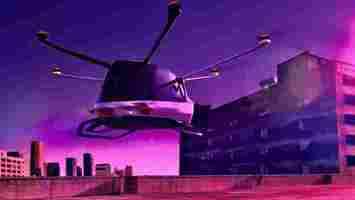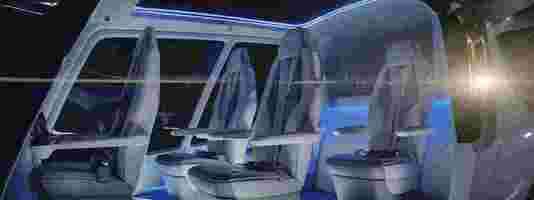Move over, batteries: green hydrogen is the key to getting flying taxis off the ground
VTOL (vertical take-off and landing) aircraft are rapidly growing from prototypes to commercial vehicles. But while most prioritize electric batteries, there’s a suite of companies developing hydrogen -powered VTOLs, including the Skai from US company Alaka’i.

I recently spoke to Brian Morrison, co-founder and Director , to find out more.
Why is Skai using hydrogen, not lithium-ion batteries?
Firstly, I was curious why hydrogen instead of Lithium-ion batteries. Morrison said:
“Lithium-ion batteries scare me.” He recalled the Boeing 787 lithium-ion battery fires in 1987. Boeing had delivered the aircraft to the airline just 18 days prior. In that time, the plane logged 22 flight cycles without incident.
Another 787 made an emergency landing in Japan after pilots received a battery malfunction warning five days later.
These two events led the FAA to ground the entire 787 fleet. It was the first time the agency had given such an order for a line of aircraft since 1979.
As Morrison explained:
Morrison has an extensive history in aviation, including developing black box recorders. He recalled:
A lonely approach to aircraft innovation
Morrison refocused on hydrogen fuel cells, noting a family history. His dad was a senior program manager on the Apollo program — the Apollo mission used fuel cells to generate electricity. He filed the first patents in 2013, and he notes:
How receptive is the FAA to a hydrogen VTOL like Skai?
Morrisonn has a long history of involvement in flight certifications for Boeing and Airbus. He explained:
According to Morrison, the biggest challenge from the FAA standpoint was the uniqueness of the vehicle:
VTOL production is a highly competitive space
How does the Skai team stack up to other founders in the space? Morrison said:
Long-distance flight with easy refueling infrastructure


The Skai is being made to handle a four-hour flight without the need to refuel. It’s able to land almost anywhere as it hasn’t the refueling infrastructure limitations of traditional eVTOLs.
As Morrison asserts:
He also noted that nobody wants to talk about the emissions behind the energy produced by megawatt eVTOL battery chargers.
Skai has signed a deal with Orbital Marine in the UK to take tidal energy from the River Thames and convert it to green hydrogen. Definitely a powerful collaboration.
What’s the market for a hydrogen VTOL like Skai?
So, who’s going to fly in a Skai?
Emergency responders and the US National Guard are a crucial audience for Skai, especially when they otherwise can’t access jet fuel due to flooding.
Further, the National Guard can operate under military authority, exempting them from FAA certification requirements. This makes it possible to build and deliver vehicles to the National Guard much earlier.
Cardinal missions are also a focus. In these, VTOLs are operated to offshore locations ahead of FAA certification carry supplies, providing an opportunity to gain experience with a vehicle.
But everyday aviation is also in the works too. Skai has a letter of intent with a LA company to buy 40 vehicles to start and an option for as many as 1320 vehicles for traditional people moving.
Of course, the challenge is getting from idea to end product.
The economy of scale
One of the biggest problems in aviation has been an inability to scale. As Morrison explained: “They see mass production across the entire industry as producing 900 aircraft a year. That’s not mass production.”
Alaka’i’s goal from day one has been to design a vehicle with automotive standards. Thus, an automotive-style production line makes it easy to scale. According to Morrison:
If you ask me, cheaper production costs make it possible to achieve mass production. Cheaper aircraft also means more affordable flights. So while Skai won’t be first in the sky, it does offers a green pathway into the future of aviation. And that’s never been more critical than now.
Tesla wants to accept Bitcoin payments in the near future
According to reports and a Securities and Exchange Commission filing, electric vehicle maker Tesla has bought a shit tonne of Bitcoin, and might even accept the perennial cryptocurrency as payment for its cars at some point in the future.

The SEC filing, made earlier today, disclosed that Tesla has bought $1.5 billion worth of Bitcoin, pushing its price to over $40,000 in the process .
The EV company is also reportedly entertaining the idea of letting customers use the cryptocurrency to buy its cars in the future.
However, take that with $1.5 billion worth of salt, because there is still regulatory uncertainty around that.
Before Tesla accepts Bitcoin as payment for its cars, it would need to figure out how to process payments, hold the digital coins, and price its vehicles taking into consideration the extreme volatility of the internet money.
In the filing, Tesla said that it “expect[s] to begin accepting bitcoin as a form of payment for [its] products in the near future, subject to applicable laws and initially on a limited basis, which [it] may or may not liquidate upon receipt.”
So it’s all quite vague so far.
Tesla, and Musk in particular, is no stranger to blockchain and cryptocurrencies. Musk has often meme’d about the likes of Dogecoin , whilst Tesla has reportedly used blockchain-based tech to track elements of its supply chain.
SHIFT is brought to you by Polestar. It’s time to accelerate the shift to sustainable mobility. That is why Polestar combines electric driving with cutting-edge design and thrilling performance. Find out how .
TIL: Dubai uses AI to plan its bus routes
This article was originally published by Sarah Wray on Cities Today , the leading news platform on urban mobility and innovation, reaching an international audience of city leaders. For the latest updates follow Cities Today on Twitter , Facebook , LinkedIn , Instagram , and YouTube , or sign up for Cities Today News.

Dubai’s Roads and Transport Authority (RTA) is exploring the use of artificial intelligence (AI) to plot more efficient bus routes based on how they are used throughout the day.
Machine learning (ML) algorithms could eventually inform updates to 150 routes used by 2,158 buses across Dubai, the RTA said.
The authority trialled the system on ten public bus routes over thirty days, using Nol Card (Dubai’s public transport smart card) data to understand patterns such as which bus stops were busy all day, which were primarily used during peak hours and those that were rarely used.
The one-month trial cut wasted time on bus routes by 13.3 percent, the RTA reports.
Ahmed Mahboub, Executive Director of Smart Services, Corporate Technology Support Services Sector, RTA, commented: “By using machine learning algorithms in analyzing the captured data, departments can build up systems and take decisions with reference to abolishing certain stops, or proposing an express service that skips those stops, while ensuring customer needs are always addressed. Such a process will contribute to improving this vital service.”
The technology could also reduce fuel consumption and carbon emissions and save time for staff, he added.
The RTA said the approach is in line with the United Arab Emirate government’s Artificial Intelligence Strategy as well as its own internal goals. It could also be of interest to cities and public transport operators more widely as they consider how to plan for the future amid the COVID-19 pandemic, which has upended the patterns which mobility systems have been based around .
SHIFT is brought to you by Polestar. It’s time to accelerate the shift to sustainable mobility. That is why Polestar combines electric driving with cutting-edge design and thrilling performance. Find out how .